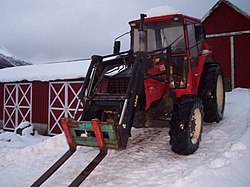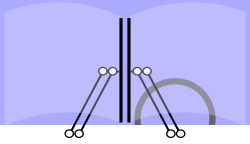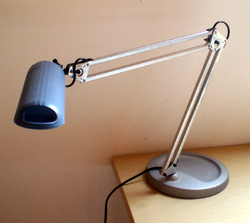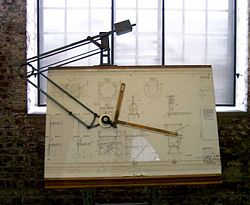Parallelogram guide
In technology, a parallelogram guide designates a mechanism with which an object attached to a double arm is held at the original angle in the plane perpendicular to the axis of rotation while the arm is pivoted . It is a guide gear , i.e. H. a transmission of the four-bar chain , the opposing links of which are of equal length, thus forming a parallelogram . In the example of the lifting arms in the illustration opposite, the short links (the cranks) keep their direction when lifting and lowering. The simple arm at the top right is designed as a crank at each end (above for the upper, below for the middle parallelogram guide).
application
Parallelogram guides are used in a variety of ways in technical equipment in which a load is moved in space while maintaining its angular position: with the three-point hydraulics on tractors for lifting and lowering attachments, when moving piece goods with the front loader and with some aerial work platforms . In steam engines it is part of Watt's parallelogram .
On a smaller scale, the principle can be found in the swivel arms of lamps, microphone stands, PC monitor holders or in the steadycam system. With these two spring-loaded parallelograms coupled to one another, in conjunction with the movable mounting at the base, enable the guided movement in three dimensions. With the pantograph , a movement is proportionally scaled with the help of a parallelogram.
Front loader : The incline of the front fork does not change when it is lifted. Prerequisite: the hydraulically adjustable upper arm set to the same length as the lower arm.
Two windshield wipers (independent of each other) : The wipers remain vertical when wiping.
Desk lamp with two double arms. The lamp keeps its direction in space when moving up and down and when pivoting back and forth.
Drawing machine with two double arms. The drawing header with rulers retains its direction in the drawing plane when moving up and down and when swiveling back and forth.




